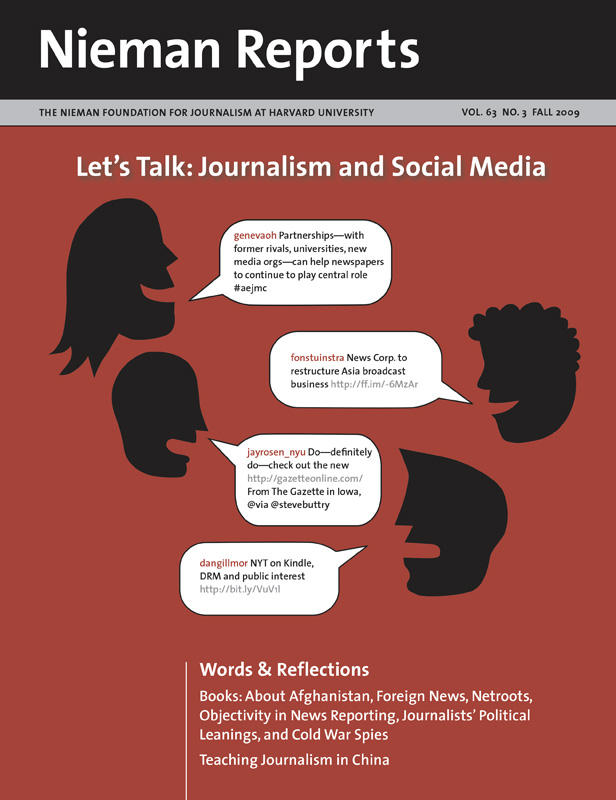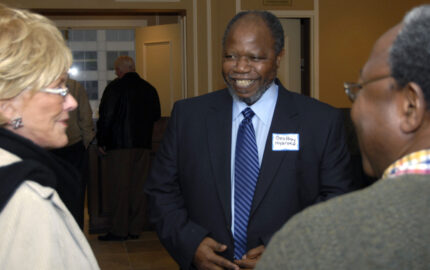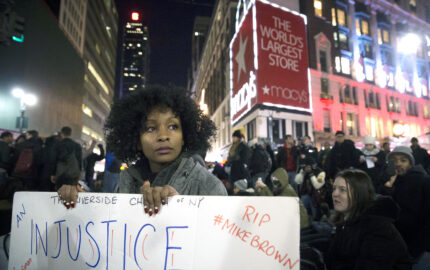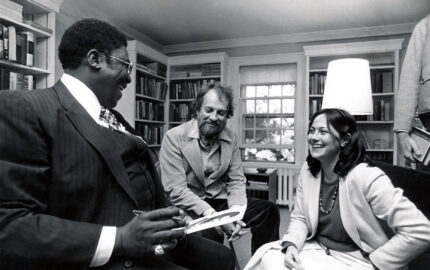At the end of 2007 I took the now-familiar buyout route as my organization, Copley News Service, began a slide toward oblivion. A year later I began a SIDEBAR
"An Opposing Viewpoint: The Struggle to Be Heard"
- Jerry Kammernew job, with a title that feels elaborate to someone who for three decades was happy to list “reporter” as my line of work. I’m a senior research fellow at the Center for Immigration Studies (CIS), a Washington think-tank that advocates reduced immigration.
It’s a big shift to be an advocate. But I approach my work here with the same fundamental goal that animated my reporting. I want to help inform public discussion about a complex, rancorous issue that is important to the future of our country. My motto remains what it was when I reported on immigration: always hard-headed, never hard-hearted.
I began observing immigration in the late 1980s, when I was northern Mexico correspondent for The Arizona Republic. Later, as I lived in Phoenix during the huge illegal influx that followed the 1994 peso collapse, I developed an appreciation of the immigrants’ struggles and of the anxieties often felt in receiving communities.
I believe that the scale of immigration has become overwhelming. Two decades ago, illegal immigration was mostly a matter of people leaving seven or eight states in Mexico and heading to five or six U.S. states. But in the aftermath of the amnesty that Congress provided in 1986 to some three million illegal immigrants, immigration has exploded. Now immigrants are coming in large numbers from all regions of Mexico and from many other countries to all regions of the United States. There’s no telling how many millions more, now plugged into immigration networks, intend to come.
I have two principal concerns. First, that the influx of mostly poor people from desperate parts of the Third World is importing a new permanent underclass to the bottom rungs of an economy that is losing its middle rungs. This threatens to bring us the social structure of Latin America.
Second, immigration is the demographic engine that is driving the United States toward a doubling of its population by late in this century. The social, political and environmental consequences would be enormous. Yet, immigration demographics receive scant attention in the press. Meanwhile, environmental groups like the Sierra Club have retreated from the issue, muzzled by political correctness and liberal coalition politics.
My concerns are fundamentally progressive. But I believe that the late Richard Estrada, who worked briefly at CIS before he joined the editorial board of The Dallas Morning News, had it right when he wrote that “apologists for illegal immigration tend to be activists and ivory-tower academics who opposed any immigration controls from Day One; Hispanic advocates who worship at the altar of political clout based on numerical increases; liberals a generation or two removed from having to worry about competition for jobs in the secondary labor market; profiteering agribusinessmen (and certain other employers), and libertarians who do not care so much how things turn out in practice as long as they work in theory.”
My work at CIS is allowing me to pursue stories with investigative depth that is increasingly rare at newspapers. For my first project, a report on the labor markets and working conditions at six Swift meat-processing plants in six states, I had the budget to spend four to five days in each community. It was the most intensive reporting I’d done since 2005, when Copley leadership made sure we had everything we needed to pursue the Randy “Duke’’ Cunningham bribery scandal.
The biggest difference in my new job, of course, is that now I am an advocate, helping present the case for reduced immigration. I disagree with Speaker of the House Nancy Pelosi, who effusively declares that expansive immigration is “who we are’’ as a nation. I think our immigration policy should be guided less by nostalgia for our grandparents and more by concern for our grandchildren.
Despite the claims of some on Pelosi’s side of the debate, this does not make me “anti-immigrant” any more than efforts at careful management of the Pentagon budget make one anti-defense, or a program for responsible nutrition makes one anti-food. My guide star is the late Barbara Jordan who said in the mid-1990’s, when she directed a federal commission on immigration policy, that we must get serious about stopping illegal immigration in order to maintain a commitment to legal immigration. Jordan spoke passionately of the need for policy that serves the broad national interest. She spoke of us as a society, not just an economy.
Our borders are chaotic because our low-wage labor market has remained, with a few exceptions, wide open. The bargain of 1986, when Congress declared it was combining the pragmatism and compassion of amnesty with a crackdown on rogue employers, failed wretchedly. Amnesty functioned with hydraulic efficiency. Enforcement became a farce as phony documents allowed workers to pretend to be legal and employers to pretend to believe them.
Congress set the stage for the current tumult in 1965, passing legislation that sought to broaden the sources of immigration beyond traditional areas in Europe. Journalist Theodore White called it “noble, revolutionary—and probably the most thoughtless of the many acts of the Great Society.”
Every year brings examples of penetrating and vivid immigration reporting. But although immigration is now a story nationwide, few papers are up to the task. I think there are two major reasons, one straightforward, one subtle.
First, to massage a phrase: immigration isn’t rocket science; it’s far more complicated. To report fully about it requires some understanding of its historical, economic, political and cultural dimensions. A reporter needs also to understand the competing interest groups and coalitions, as well as the changes immigration brings to the workplace, schools, neighborhoods and health care systems.
The second reason is not just subtle; it’s also sinister. It involves a campaign by immigration advocacy groups to delegitimize restrictionist organizations like CIS. It is an attempt to cast us beyond the pale of reasoned and civil policy discussion.
Led by the National Council of La Raza, the advocacy groups are working in tandem with the Southern Poverty Law Center (SPLC), whose complex includes both its admirable work in battling the Ku Klux Klan and its cynical inclination to stifle public debate in the name of promoting tolerance and fighting hate.
The SPLC’s bona fides are wanting. A remarkable 2000 Harper’s Magazine exposé revealed its habit of spending “most of its time—and money—on a relentless fundraising campaign, peddling memberships in the church of tolerance with all the zeal of a circuit rider passing the collection plate.’’
Now that the Klan has faded, the SPLC is milking a new cash cow in the form of hundreds of “hate groups.” It has attempted to cast CIS as part of a network of anti-immigrant animosity, using guilt-by-association tactics out of the Joe McCarthy playbook. Unable to find hatred in our work—which is reputable enough for the U.S. Census Bureau and Department of Justice to have contracted with CIS—the SPLC warns darkly that we are part of a network with “ties to white supremacy.”
Despite the SPLC’s long record of hucksterism, hypocrisy and greed—first exposed in a Montgomery Advertiser series that was a 1995 Pulitzer Prize finalist—major organizations like The Washington Post and The New York Times have cited it as an arbiter of intolerance. The damage the smear campaign has caused us is difficult to quantify. Shortly after beginning work here, I received a call from a friend, an immigration advocate who works for a Hispanic member of Congress. I suspect she is now a former friend because she informed me she was “appalled” at my decision to work for such a “hateful” organization. I’ve learned to consider such reactions part of my new territory.
I believe the smear campaign has the effect of making some well-intentioned people decide to avoid us for fear that they, too, will be found guilty by association. Conducted in the name of tolerance and civil discussion, the campaign is itself uncivil, dishonest and antidemocratic. A desire to fight it was one of the reasons I accepted my job at CIS.
I’d like to see the advocacy groups keep in mind a noble thought expressed by Janet Murguia, president and CEO of the National Council of La Raza.In 1995, when she was working in the Clinton White House, she talked to The Kansas City Star about a flaw in the culture of Washington. Said Murguia, “One basic thing that gets lost in Washington is to just have a common sense of decency when you’re treating people. Sometimes it seems like it’s a rare commodity in this town. That’s one thing I hope I keep from my Kansas upbringing—a lot of it is a Midwestern sort of Latin American upbringing.’’
I would like to see the immigration debate conducted with respect for differing opinions. I’d like to see greater civility among the advocacy groups and greater professionalism among the journalists. I hope I can contribute on both counts.
Jerry Kammer, a 1994 Nieman Fellow, was a reporter for The Navajo Times, Gallup Independent, The Arizona Republic, and the Washington bureau of Copley News Service. He now works at the Center for Immigration Studies in Washington, D.C.
"An Opposing Viewpoint: The Struggle to Be Heard"
- Jerry Kammernew job, with a title that feels elaborate to someone who for three decades was happy to list “reporter” as my line of work. I’m a senior research fellow at the Center for Immigration Studies (CIS), a Washington think-tank that advocates reduced immigration.
It’s a big shift to be an advocate. But I approach my work here with the same fundamental goal that animated my reporting. I want to help inform public discussion about a complex, rancorous issue that is important to the future of our country. My motto remains what it was when I reported on immigration: always hard-headed, never hard-hearted.
I began observing immigration in the late 1980s, when I was northern Mexico correspondent for The Arizona Republic. Later, as I lived in Phoenix during the huge illegal influx that followed the 1994 peso collapse, I developed an appreciation of the immigrants’ struggles and of the anxieties often felt in receiving communities.
I believe that the scale of immigration has become overwhelming. Two decades ago, illegal immigration was mostly a matter of people leaving seven or eight states in Mexico and heading to five or six U.S. states. But in the aftermath of the amnesty that Congress provided in 1986 to some three million illegal immigrants, immigration has exploded. Now immigrants are coming in large numbers from all regions of Mexico and from many other countries to all regions of the United States. There’s no telling how many millions more, now plugged into immigration networks, intend to come.
I have two principal concerns. First, that the influx of mostly poor people from desperate parts of the Third World is importing a new permanent underclass to the bottom rungs of an economy that is losing its middle rungs. This threatens to bring us the social structure of Latin America.
Second, immigration is the demographic engine that is driving the United States toward a doubling of its population by late in this century. The social, political and environmental consequences would be enormous. Yet, immigration demographics receive scant attention in the press. Meanwhile, environmental groups like the Sierra Club have retreated from the issue, muzzled by political correctness and liberal coalition politics.
My concerns are fundamentally progressive. But I believe that the late Richard Estrada, who worked briefly at CIS before he joined the editorial board of The Dallas Morning News, had it right when he wrote that “apologists for illegal immigration tend to be activists and ivory-tower academics who opposed any immigration controls from Day One; Hispanic advocates who worship at the altar of political clout based on numerical increases; liberals a generation or two removed from having to worry about competition for jobs in the secondary labor market; profiteering agribusinessmen (and certain other employers), and libertarians who do not care so much how things turn out in practice as long as they work in theory.”
My work at CIS is allowing me to pursue stories with investigative depth that is increasingly rare at newspapers. For my first project, a report on the labor markets and working conditions at six Swift meat-processing plants in six states, I had the budget to spend four to five days in each community. It was the most intensive reporting I’d done since 2005, when Copley leadership made sure we had everything we needed to pursue the Randy “Duke’’ Cunningham bribery scandal.
The biggest difference in my new job, of course, is that now I am an advocate, helping present the case for reduced immigration. I disagree with Speaker of the House Nancy Pelosi, who effusively declares that expansive immigration is “who we are’’ as a nation. I think our immigration policy should be guided less by nostalgia for our grandparents and more by concern for our grandchildren.
Despite the claims of some on Pelosi’s side of the debate, this does not make me “anti-immigrant” any more than efforts at careful management of the Pentagon budget make one anti-defense, or a program for responsible nutrition makes one anti-food. My guide star is the late Barbara Jordan who said in the mid-1990’s, when she directed a federal commission on immigration policy, that we must get serious about stopping illegal immigration in order to maintain a commitment to legal immigration. Jordan spoke passionately of the need for policy that serves the broad national interest. She spoke of us as a society, not just an economy.
Our borders are chaotic because our low-wage labor market has remained, with a few exceptions, wide open. The bargain of 1986, when Congress declared it was combining the pragmatism and compassion of amnesty with a crackdown on rogue employers, failed wretchedly. Amnesty functioned with hydraulic efficiency. Enforcement became a farce as phony documents allowed workers to pretend to be legal and employers to pretend to believe them.
Congress set the stage for the current tumult in 1965, passing legislation that sought to broaden the sources of immigration beyond traditional areas in Europe. Journalist Theodore White called it “noble, revolutionary—and probably the most thoughtless of the many acts of the Great Society.”
Every year brings examples of penetrating and vivid immigration reporting. But although immigration is now a story nationwide, few papers are up to the task. I think there are two major reasons, one straightforward, one subtle.
First, to massage a phrase: immigration isn’t rocket science; it’s far more complicated. To report fully about it requires some understanding of its historical, economic, political and cultural dimensions. A reporter needs also to understand the competing interest groups and coalitions, as well as the changes immigration brings to the workplace, schools, neighborhoods and health care systems.
The second reason is not just subtle; it’s also sinister. It involves a campaign by immigration advocacy groups to delegitimize restrictionist organizations like CIS. It is an attempt to cast us beyond the pale of reasoned and civil policy discussion.
Led by the National Council of La Raza, the advocacy groups are working in tandem with the Southern Poverty Law Center (SPLC), whose complex includes both its admirable work in battling the Ku Klux Klan and its cynical inclination to stifle public debate in the name of promoting tolerance and fighting hate.
The SPLC’s bona fides are wanting. A remarkable 2000 Harper’s Magazine exposé revealed its habit of spending “most of its time—and money—on a relentless fundraising campaign, peddling memberships in the church of tolerance with all the zeal of a circuit rider passing the collection plate.’’
Now that the Klan has faded, the SPLC is milking a new cash cow in the form of hundreds of “hate groups.” It has attempted to cast CIS as part of a network of anti-immigrant animosity, using guilt-by-association tactics out of the Joe McCarthy playbook. Unable to find hatred in our work—which is reputable enough for the U.S. Census Bureau and Department of Justice to have contracted with CIS—the SPLC warns darkly that we are part of a network with “ties to white supremacy.”
Despite the SPLC’s long record of hucksterism, hypocrisy and greed—first exposed in a Montgomery Advertiser series that was a 1995 Pulitzer Prize finalist—major organizations like The Washington Post and The New York Times have cited it as an arbiter of intolerance. The damage the smear campaign has caused us is difficult to quantify. Shortly after beginning work here, I received a call from a friend, an immigration advocate who works for a Hispanic member of Congress. I suspect she is now a former friend because she informed me she was “appalled” at my decision to work for such a “hateful” organization. I’ve learned to consider such reactions part of my new territory.
I believe the smear campaign has the effect of making some well-intentioned people decide to avoid us for fear that they, too, will be found guilty by association. Conducted in the name of tolerance and civil discussion, the campaign is itself uncivil, dishonest and antidemocratic. A desire to fight it was one of the reasons I accepted my job at CIS.
I’d like to see the advocacy groups keep in mind a noble thought expressed by Janet Murguia, president and CEO of the National Council of La Raza.In 1995, when she was working in the Clinton White House, she talked to The Kansas City Star about a flaw in the culture of Washington. Said Murguia, “One basic thing that gets lost in Washington is to just have a common sense of decency when you’re treating people. Sometimes it seems like it’s a rare commodity in this town. That’s one thing I hope I keep from my Kansas upbringing—a lot of it is a Midwestern sort of Latin American upbringing.’’
I would like to see the immigration debate conducted with respect for differing opinions. I’d like to see greater civility among the advocacy groups and greater professionalism among the journalists. I hope I can contribute on both counts.
Jerry Kammer, a 1994 Nieman Fellow, was a reporter for The Navajo Times, Gallup Independent, The Arizona Republic, and the Washington bureau of Copley News Service. He now works at the Center for Immigration Studies in Washington, D.C.



